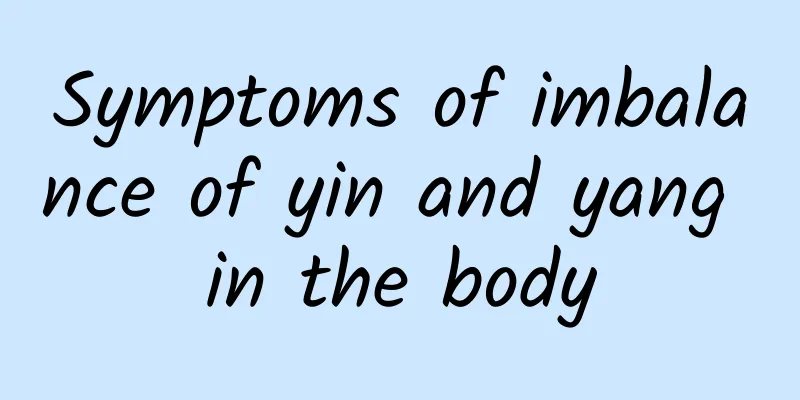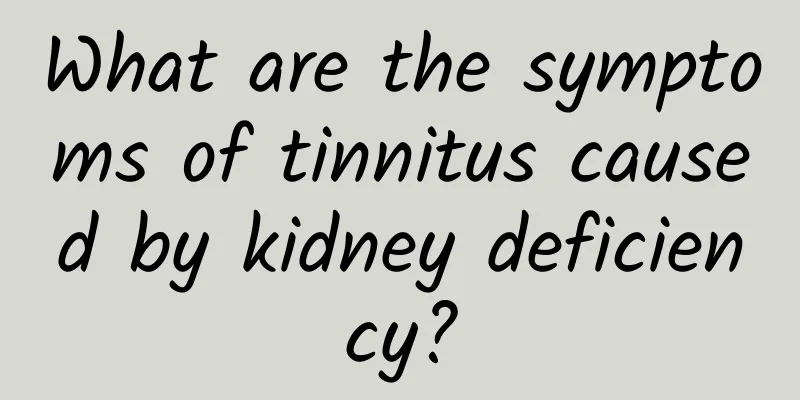Symptoms of imbalance of yin and yang in the body

|
When we go to see a Chinese medicine doctor, sometimes he will say the four words "yin and yang imbalance", but there is no such disease in Western medicine. In fact, the so-called imbalance of yin and yang is a symptom in traditional Chinese medicine, also known as pathogenesis. As we all know, the yin and yang in the human body are relative and maintain a balance with each other. If this balance is lost, problems arise. This is the reason for the imbalance of yin and yang. So what are the symptoms of imbalance of yin and yang in the body? Clinical manifestations Clinically, the pathological changes of yin and yang imbalance are often closely related to the cold or hot nature of the disease. "Suwen·Yin Yang Ying Xiang Da Lun" says: "Yang prevails, then it is hot; Yin prevails, then it is cold." "Suwen·Tiaojing Lun" also says: "Yang deficiency causes external cold; Yin deficiency causes internal heat; Yang excess causes external heat; Yin excess causes internal cold." This shows that during the course of the disease, the human body often experiences pathological changes of a certain nature, such as cold or heat, a mixture of cold and heat, or true or false cold and heat. Therefore, the imbalance of yin and yang has become a basic pathogenesis with universal significance for explaining the changes of cold and heat in the disease. Zhang Jingyue of the Ming Dynasty said in Jingyue Complete Works: "Cold and heat are the changes of yin and yang." 1. The clinical manifestations of Yang Sheng are mostly high fever, aversion to heat, restlessness, flushed face, thirst, dry stool, yellow urine, yellow tongue coating and rapid pulse, etc., which are symptoms of solid heat. 2. The clinical manifestations of Yin excess are mostly cold limbs, aversion to cold and preference for warmth, cold pain in the abdomen, or diarrhea, edema, curled up and less movement, bland mouth without thirst, clear and thin sputum, white tongue coating and slow pulse, etc., which are symptoms of solid cold. 3. The clinical manifestations of Yang deficiency are the decline of Yang Qi and the decreased function of warming the whole body, while Yin and cold are relatively prevalent. Symptoms include fear of cold and preference for warmth, cold body and limbs, mental fatigue, tiredness and less movement, weak pulse, diarrhea, clear and long urination, and edema. 4. The clinical manifestations of Yin deficiency are insufficient Yin fluid, which loses its function of moisturizing and nourishing. Symptoms include dry mouth, dry throat, dry lips, dry skin, dry stool and less urine, red tongue with less coating, emaciation, night sweats, weak pulse, hot flashes in the afternoon, fever in the five hearts, or red cheeks with fever. 5. Clinically, Yang Sheng Ge Yin can be seen with symptoms of internal heat such as burning sensation in the chest and abdomen, aversion to heat, dry mouth and tongue, thirst and preference for cold drinks, dry stools and red urine, red tongue with yellow coating, as well as false cold signs such as cold hands and feet and a deep pulse. 6. Clinically, Yin is stronger than Yang and the symptoms of deficiency and coldness include cold limbs, clear diarrhea, long and clear urination, pale tongue with white coating. At the same time, there are signs of false heat such as fever with the patient wanting to cover himself with clothes, red face as if in makeup, and a strong pulse with no root when pressed. 7. The clinical manifestations of Yang excess and Yin depletion include dry mouth and tongue, thirst, dry stool and scanty red urine, dry skin, and other symptoms of Yin fluid deficiency and loss of moisture. 8. Excessive Yin detrimental to Yang. Clinically, symptoms of Yang deficiency, such as fear of cold, cold limbs, pale face, clear urine, loose stools, etc., can be seen as a lack of warmth, as well as a variety of functional impairment symptoms. 9. The clinical manifestations of Yang damage and Yin damage are often as deficiency-cold syndrome and deficiency-heat syndrome, but the deficiency-cold symptoms are the main ones, followed by the deficiency-heat symptoms. 10. The clinical manifestations of Yin damage and Yang damage are also the combination of deficiency-cold syndrome and deficiency-heat syndrome, but the symptoms of deficiency-heat are the main ones, followed by the symptoms of deficiency-cold. 11. Clinically, symptoms of Yang loss include profuse sweating, thin and cold sweat, cold skin and hands and feet, chillness and curling up, mental depression, indifference, and even coma, pale complexion, weak pulse, and other symptoms of deficiency and cold accompanied by exhaustion crisis. 12. Clinically, loss of Yin can be seen with symptoms such as oily sweat, hot and sticky sweat, warm hands and feet, wheezing, thirst, and irritability, or coma and delirium, thin and shriveled body, wrinkled skin, sunken eye sockets, chapped lips and tongue, red and dry tongue, weak and rapid pulse, etc., which are signs of deficiency heat and exhaustion crisis. |
<<: What are the effects of cooking Dendrobium and American ginseng?
>>: What are the effects and functions of using ginger to wash your hair?
Recommend
What to do if eczema breaks and oozes yellow water
Eczema is a relatively common disease at present....
Five summer dehumidifying soup recipes to help you cool down and get rid of moisture
In the south, although the summer is very hot, th...
What causes pain on the left side of the pelvis?
Many women experience pain on the left side of th...
What causes asthma in children?
Bronchitis is associated with colds, inflammation...
What is the shelf life of Ganoderma lucidum spore powder?
In life, in order to stay healthy, many friends l...
Cordyceps, Ginseng and Sea Dog Pills
Cordyceps, ginseng and sea dog pills are actually...
The harm of leaning your feet against the wall at 90 degrees
Many of my friends don’t have much time to exerci...
How to stretch the leg to check for meniscus injury
Meniscus injury is a relatively common condition,...
What happens if pharyngitis becomes serious without treatment?
There are some people who, when they are sick, re...
Is long-term cupping good for the body?
With the development of society, more and more pe...
Can I drink chicken soup when I have a cold? Does it help treat a cold?
Colds are very common diseases, but many friends ...
What to do if warts grow on your arms
Warts are a common skin virus. Seeing the virus m...
One-hour glucose tolerance test in pregnant women
Many pregnant women will find that they have high...
Candidal vulvovaginitis
For women who have started sexual life, the most ...
How to treat kidney deficiency
Kidney deficiency is common among adults, especia...









